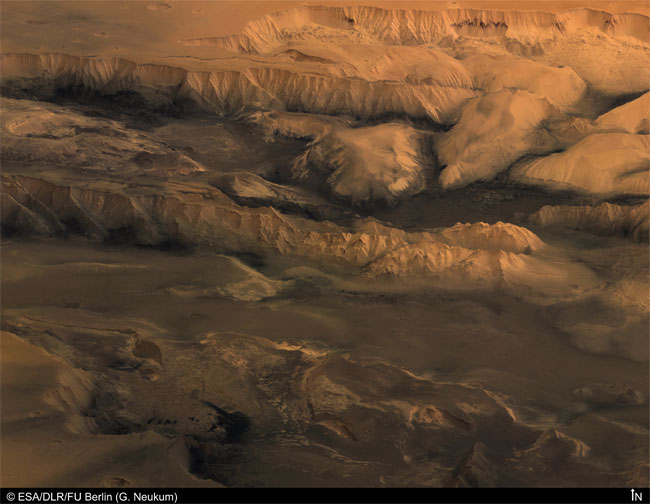Exclusive: NASA Researchers Claim Evidence of Present Life on Mars

WASHINGTON -- A pair of NASA scientists told a group of space officials at a private meeting here Sunday that they have found strong evidence that life may exist today on Mars, hidden away in caves and sustained by pockets of water.
The scientists, Carol Stoker and Larry Lemke of NASA's Ames Research Center in Silicon Valley, told the group that they have submitted their findings to the journal Nature for publication in May, and their paper currently is being peer reviewed.
What Stoker and Lemke have found, according to several attendees of the private meeting, is not direct proof of life on Mars, but methane signatures and other signs of possible biological activity remarkably similar to those recently discovered in caves here on Earth.
Stoker and other researchers have long theorized that the Martian subsurface could harbor biological organisms that have developed unusual strategies for existing in extreme environments. That suspicion led Stoker and a team of U.S. and Spanish researchers in 2003 to southwestern Spain to search for subsurface life near the Rio Tinto river--so-called because of its reddish tint--the product of iron being dissolved in its highly acidic water.
Stoker did not respond to messages left Tuesday on her voice mail at Ames.
Stoker told SPACE.com in 2003, weeks before leading the expedition to southwestern Spain, that by studying the very acidic Rio Tinto, she and other scientists hoped to characterize the potential for a "chemical bioreactor" in the subsurface - an underground microbial ecosystem of sorts that might well control the chemistry of the surface environment.
Making such a discovery at Rio Tinto, Stoker said in 2003, would mean uncovering a new, previously uncharacterized metabolic strategy for living in the subsurface. "For that reason, the search for life in the Rio Tinto is a good analog for searching for life on Mars," she said.
Get the Space.com Newsletter
Breaking space news, the latest updates on rocket launches, skywatching events and more!
Stoker told her private audience Sunday evening that by comparing discoveries made at Rio Tinto with data collected by ground-based telescopes and orbiting spacecraft, including the European Space Agency's Mars Express, she and Lemke have made a very a strong case that life exists below Mars' surface.
The two scientists, according to sources at the Sunday meeting, based their case in part on Mars' fluctuating methane signatures that could be a sign of an active underground biosphere and nearby surface concentrations of the sulfate jarosite, a mineral salt found on Earth in hot springs and other acidic bodies of water like Rio Tinto that have been found to harbor life despite their inhospitable environments.
One of NASA's Mars Exploration Rovers, Opportunity, bolstered the case for water on Mars when it discovered jarosite and other mineral salts on a rocky outcropping in Merdiani Planum, the intrepid rover's landing site chosen because scientists believe the area was once covered by salty sea.
Stoker and Lemke's research could lead the search for Martian biology underground, where standing water would help account for the curious methane signatures the two have been analyzing.
"They are desperate to find out what could be producing the methane," one attendee told Space News. "Their answer is drill, drill, drill."
NASA has no firm plans for sending a drill-equipped lander to Mars, but the agency is planning to launch a powerful new rover in 2009 that could help shed additional light on Stoker and Lemke's intriguing findings. Dubbed the Mars Science Laboratory, the nuclear-powered rover will range farther than any of its predecessors and will be carrying an advanced mass spectrometer to sniff out methane with greater sensitivity than any instrument flown to date.
In 1996 a team of NASA and Stanford University researchers created a stir when they published findings that meteorites recovered from the Allen Hills region of Antarctica contained evidence of possible past life on Mars. Those findings remain controversial, with many researchers unconvinced that those meteorites held even possible evidence that very primitive microbial life had once existed on Mars.
Related Coverage



- The Rio Tinto Investigation
- What Could Live on Mars? Wild Things
- Evidence for Underground Water on Mars
- Evidence for Methane in Mars' Atmosphere
- Special Report: June 20, 2000 Evidence of Water on Mars
- VOTE: The Best Mars Rover Images
Join our Space Forums to keep talking space on the latest missions, night sky and more! And if you have a news tip, correction or comment, let us know at: community@space.com.
Brian Berger is the Editor-in-Chief of SpaceNews, a bi-weekly space industry news magazine, and SpaceNews.com. He joined SpaceNews covering NASA in 1998 and was named Senior Staff Writer in 2004 before becoming Deputy Editor in 2008. Brian's reporting on NASA's 2003 Columbia space shuttle accident and received the Communications Award from the National Space Club Huntsville Chapter in 2019. Brian received a bachelor's degree in magazine production and editing from Ohio University's E.W. Scripps School of Journalism.